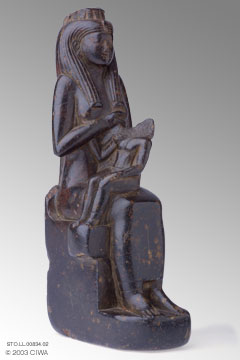Queen as Isis nursing, Dyn. 12

Links to other views:⇒ Larger View⇒ Back if scripting is off, click the ⇒ instead. Links to others from Dynasty 12Bronze mirror, double Horus, Dyn. 12Bronze of Goddess Nebethetepet, Dyn. 12 Ka statue of King Amenemhet III, Dyn. 12 King as Horus-the-Child, Dyn. 12 Limestone shawabti, Dyn. 12 Limestone shawabti, Dyn. 12 New year flask, royal gift of sacred water Panel from outer wooden coffin, Dyn. 12 Scarab of Senusret I, Dyn. 12 Scarab with Lord Ptah, Dyn. 12 Scarab with Ra and four cobras, Dyn. 12 Scarab with Thot Ka Ra, Dyn. 12 Shawabti of Im-Neferw-Neb, Dyn. 12 Shawabti ‘substitute of the dead’, Dyn.12 Shawabti, ‘substitute of the dead’, Dyn.12 Stone head of a king, Dyn. 12 Wood statue of Amenemhat II, Dyn. 12 Links to others representing Isis-HathorQueen as Isis-Hathor nursing, Dyn. 21Links to others of type Statuette-womanBronze female dancer, Rome, 200-27 BCBronze goddess Neith, Ptolemaic Period Bronze of a queen nursing, Dyn. 25 Bronze of Ceres, Rome, 200 BC-307 AD Bronze of Goddess Nebethetepet, Dyn. 12 Bronze of Mut, Ptolemaic Period Bronze Venus, Alexandria, 50 BC-50 AD Etruscan young woman, 570-550 BC Gilded statue of a queen, Early Dynastic Hathor as a woman, cow headed, N.K. Protodynastic female statuette, Dyn. 0 Queen Aqaluqa as Isis nursing, Dyn. 25 Queen as Goddess Mut, Dyn.18 Queen as Isis nursing, Dyn. 25 Queen as Isis-Hathor nursing, Dyn. 21 Queen Hatshepsut as Goddess Mut, Dyn. 18 Queen Hatshepsut as Hathor, Dyn. 18 Queen Isis as Isis nursing Thutmose III Queen Isitnefret as Isis nursing, Dyn. 19 Queen Karama as Goddess Neith, Dyn. 22 Terracotta young woman, Greece, 450 BC Victory and Athena, terracotta, Greece Woman and girl, Tanagra, 340-300 BC Woman with elaborate headdress, Crete |
This exquisite serpentinite stone statuette represents a queen as Goddess Isis nursing Horus the Child. The identity of this queen will forever remain a mystery, but the impeccable classicism of the style is strongly indicative of a Dynasty 12 work. When De Meulenaere (1976:54) wrote: Her voluminous tripartite headgear exposes the ears and the modeling of her face. As a woman of the Middle Kingdom, she wears an elegant tight-fitting dress held by two wide straps. These are characteristics of the work of Middle Kingdom sculptors. Elongated eyes, the eyebrow line, a thin-lipped mouth, all tie this piece to the reign of Sanusret II.he was discussing the “bust of a woman” from the Brooklyn Museum, but he might as well have been describing this queen. Seated on her black granite seat, and ritually nursing her child Horus, the queen wears bracelets, armlets, and anklets. The child, already tall and muscular, also wears bracelets, armlets, and anklets. Additionally, a pendant amulet can be seen hanging from his neck. This could be telling, because this type of jewelry (already worn by Sanusret II) was consistently represented on statuary of Sanusret III (1878-1841 BC) at all ages, and worn later by his son Amenhemet III (1842-1797 BC). The back pillar is inscribed with hieroglyphs which read: “To whom life is given, introduce pa-i-bastet, great daughter and heart of the lady of the house ta-hor-i” (di ankh b s pa i bastett sa wr ib nb t pr erta hor i). But we have all reasons to believe that this inscription, apparently made in Dynasty 22 (945-712 BC), was the latest of perhaps several successive usurpations of the original dedication. Indeed, the back pillar is considerably thinner than it should be in this type of sculpture, suggesting repeated grinding and re-inscribing, causing the permanent loss of the identity of its original subject. For an almost identical sculpture carved some 1,200 years later, see item 00825 from this collection. Bibliography (for this item)Allen, James P.2000 Middle Egyptian: An Introduction to the Language and Culture of Hieroglyphs. Cambridge University Press, Cambridge, UK. Budge, E. A. Wallis, Sir 1978 Egyptian Hieroglyphic Dictionary (Originally published in 1920). Dover Publications, New York, NY. Clayton, Peter A. 1994 Chronicle of the Pharaohs: The Reign-by-Reign Record of the Rulers and Dynasties of Ancient Egypt. Thames and Hudson, London, UK. ( 80, 84) De Meulenaere, Herman 1976 Egypte Eternelle: Chefs d’oeuvre du Brooklyn Museum. Ministère de la Culture, Brussels, Belgium. ( 54 pl. # 26) Gardiner, Alan 1957 Egyptian Grammar. 3rd edition. Oxford University Press, London, United Kingdom. Khalil, Hassan M. 1976 Preliminary Studies on the Sanusret Collection. Manuscript, Musée l’Egypte et le Monde Antique, Monaco-Ville, Monaco. ( [I] 19-23) Vandier, J 1958 Manuel d’Archeologie Egyptienne. Tome III: Les grandes époques—la statuaire. A. et J. Picard, Paris, France. |